脚踝扭伤怎么办?(英文版)
- 格式:ppt
- 大小:634.50 KB
- 文档页数:10

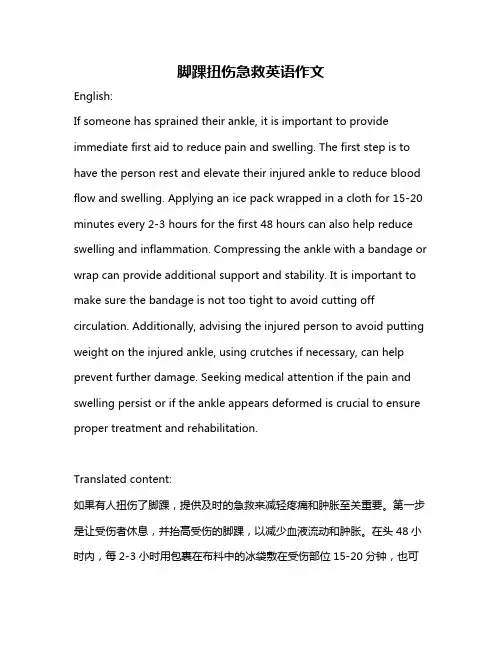
脚踝扭伤急救英语作文English:If someone has sprained their ankle, it is important to provide immediate first aid to reduce pain and swelling. The first step is to have the person rest and elevate their injured ankle to reduce blood flow and swelling. Applying an ice pack wrapped in a cloth for 15-20 minutes every 2-3 hours for the first 48 hours can also help reduce swelling and inflammation. Compressing the ankle with a bandage or wrap can provide additional support and stability. It is important to make sure the bandage is not too tight to avoid cutting off circulation. Additionally, advising the injured person to avoid putting weight on the injured ankle, using crutches if necessary, can help prevent further damage. Seeking medical attention if the pain and swelling persist or if the ankle appears deformed is crucial to ensure proper treatment and rehabilitation.Translated content:如果有人扭伤了脚踝,提供及时的急救来减轻疼痛和肿胀至关重要。
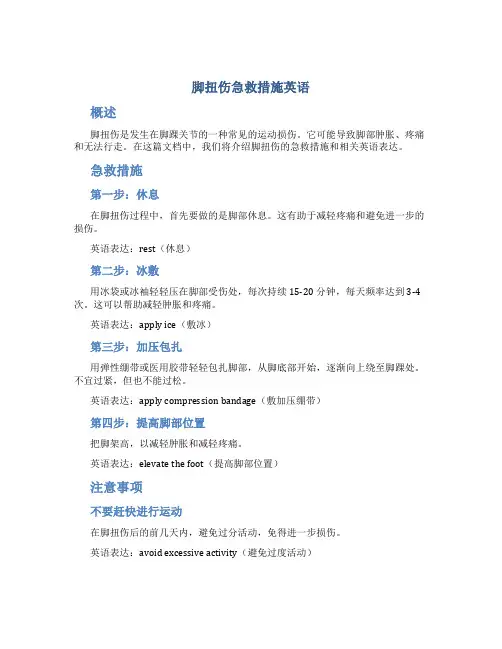
脚扭伤急救措施英语概述脚扭伤是发生在脚踝关节的一种常见的运动损伤。
它可能导致脚部肿胀、疼痛和无法行走。
在这篇文档中,我们将介绍脚扭伤的急救措施和相关英语表达。
急救措施第一步:休息在脚扭伤过程中,首先要做的是脚部休息。
这有助于减轻疼痛和避免进一步的损伤。
英语表达:rest(休息)第二步:冰敷用冰袋或冰袖轻轻压在脚部受伤处,每次持续 15-20 分钟,每天频率达到 3-4 次。
这可以帮助减轻肿胀和疼痛。
英语表达:apply ice(敷冰)第三步:加压包扎用弹性绷带或医用胶带轻轻包扎脚部,从脚底部开始,逐渐向上绕至脚踝处。
不宜过紧,但也不能过松。
英语表达:apply compression bandage(敷加压绷带)第四步:提高脚部位置把脚架高,以减轻肿胀和减轻疼痛。
英语表达:elevate the foot(提高脚部位置)注意事项不要赶快进行运动在脚扭伤后的前几天内,避免过分活动,免得进一步损伤。
英语表达:avoid excessive activity(避免过度活动)遵循 RICE 原则RICE 是指 Rest(休息)、Ice(敷冰)、Compression(敷加压绷带)和Elevation(提高脚部位置)。
这是一种常见的脚扭伤急救方法,可以帮助减轻疼痛和肿胀。
英语表达:follow the RICE principle(遵循 RICE 原则)寻求医疗帮助如果疼痛、肿胀或不能站立超过两天,我们建议尽快联系医护人员进行治疗。
英语表达:seek medical help(寻求医疗帮助)结论了解脚扭伤的急救措施可以减轻痛苦和避免进一步的损伤。
口头和书面英语表达能力的提高可以帮助您在海外旅行和工作中更好地与人交流,获取更多信息和资源。
希望这篇文档有助于您的学习和实践。

扭伤脚踝英语作文I twisted my ankle while playing basketball last week.It was really painful and I had to rest for a few days to recover. I applied ice and elevated my foot to reduce the swelling. I also wrapped it with a bandage for support.After a couple of days, I started doing some gentle ankle exercises to improve flexibility and strength. I also went for a physiotherapy session to speed up the healing process. It was important to take it slow and not rush back into intense physical activity.It took about a week for my ankle to feel better and I was able to walk normally again. I made sure to wear supportive shoes and avoid putting too much pressure on my injured ankle. I also continued with the exercises recommended by the physiotherapist to prevent future injuries.扭伤脚踝是上周打篮球时发生的。
当时非常疼痛,我不得不休息几天来恢复。
我用冰敷和抬高脚部来减轻肿胀。
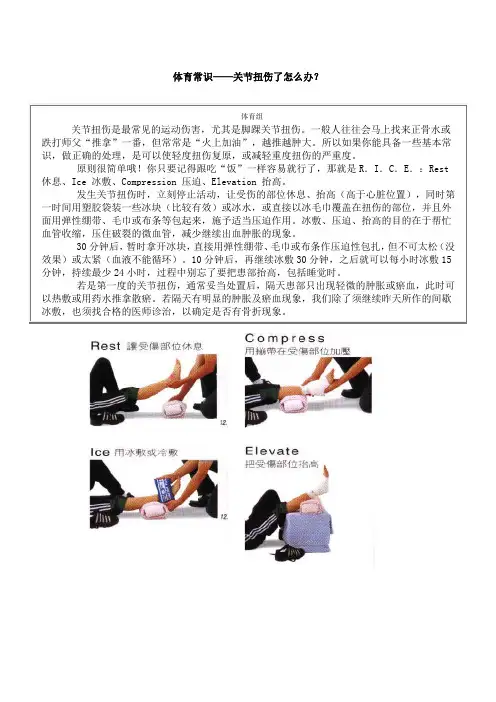
体育常识——关节扭伤了怎么办?
体育组
关节扭伤是最常见的运动伤害,尤其是脚踝关节扭伤。
一般人往往会马上找来正骨水或跌打师父“推拿”一番,但常常是“火上加油”,越推越肿大。
所以如果你能具备一些基本常识,做正确的处理,是可以使轻度扭伤复原,或减轻重度扭伤的严重度。
原则很简单哦!你只要记得跟吃“饭”一样容易就行了,那就是R.I.C.E.:Rest休息、Ice 冰敷、Compression 压迫、Elevation 抬高。
发生关节扭伤时,立刻停止活动,让受伤的部位休息、抬高(高于心脏位置),同时第一时间用塑胶袋装一些冰块(比较有效)或冰水,或直接以冰毛巾覆盖在扭伤的部位,并且外面用弹性绷带、毛巾或布条等包起来,施予适当压迫作用。
冰敷、压迫、抬高的目的在于帮忙血管收缩,压住破裂的微血管,减少继续出血肿胀的现象。
30分钟后,暂时拿开冰块,直接用弹性绷带、毛巾或布条作压迫性包扎,但不可太松(没效果)或太紧(血液不能循环)。
10分钟后,再继续冰敷30分钟,之后就可以每小时冰敷15分钟,持续最少24小时,过程中别忘了要把患部抬高,包括睡觉时。
若是第一度的关节扭伤,通常妥当处置后,隔天患部只出现轻微的肿胀或瘀血,此时可以热敷或用药水推拿散瘀。
若隔天有明显的肿胀及瘀血现象,我们除了须继续昨天所作的间歇冰敷,也须找合格的医师诊治,以确定是否有骨折现象。
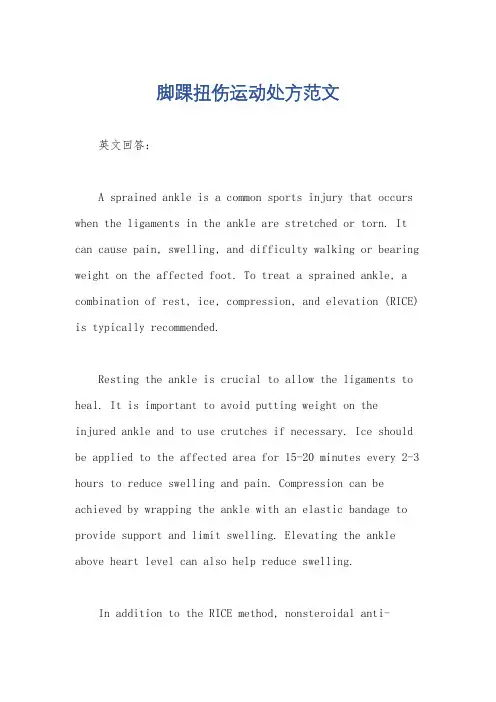
脚踝扭伤运动处方范文英文回答:A sprained ankle is a common sports injury that occurs when the ligaments in the ankle are stretched or torn. It can cause pain, swelling, and difficulty walking or bearing weight on the affected foot. To treat a sprained ankle, a combination of rest, ice, compression, and elevation (RICE) is typically recommended.Resting the ankle is crucial to allow the ligaments to heal. It is important to avoid putting weight on theinjured ankle and to use crutches if necessary. Ice should be applied to the affected area for 15-20 minutes every 2-3 hours to reduce swelling and pain. Compression can be achieved by wrapping the ankle with an elastic bandage to provide support and limit swelling. Elevating the ankle above heart level can also help reduce swelling.In addition to the RICE method, nonsteroidal anti-inflammatory drugs (NSAIDs) such as ibuprofen can be takento reduce pain and inflammation. Physical therapy exercises, such as ankle range of motion exercises and strengthening exercises, may also be prescribed to improve mobility and prevent future injuries.It is important to gradually return to physicalactivity after a sprained ankle. This can be done through a guided rehabilitation program that includes exercises to improve balance, stability, and strength. It is advisableto wear ankle braces or supportive shoes during physical activity to prevent re-injury.中文回答:脚踝扭伤是一种常见的运动损伤,发生在脚踝的韧带被拉伸或撕裂时。
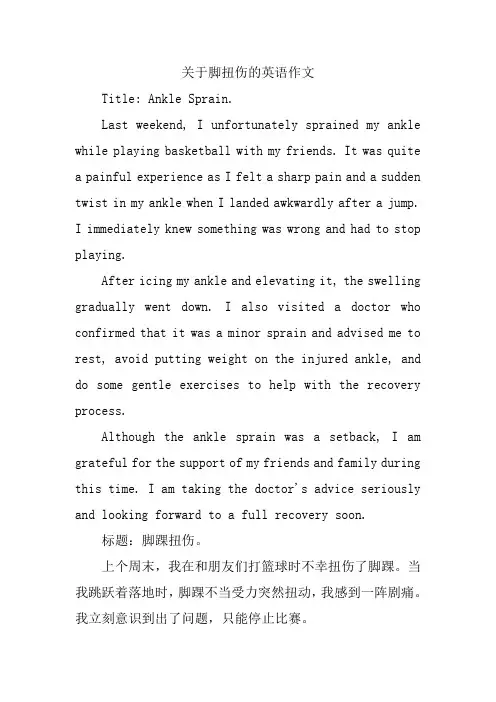
关于脚扭伤的英语作文Title: Ankle Sprain.Last weekend, I unfortunately sprained my ankle while playing basketball with my friends. It was quite a painful experience as I felt a sharp pain and a sudden twist in my ankle when I landed awkwardly after a jump.I immediately knew something was wrong and had to stop playing.After icing my ankle and elevating it, the swelling gradually went down. I also visited a doctor who confirmed that it was a minor sprain and advised me to rest, avoid putting weight on the injured ankle, and do some gentle exercises to help with the recovery process.Although the ankle sprain was a setback, I am grateful for the support of my friends and family during this time. I am taking the doctor's advice seriously and looking forward to a full recovery soon.标题:脚踝扭伤。
上个周末,我在和朋友们打篮球时不幸扭伤了脚踝。
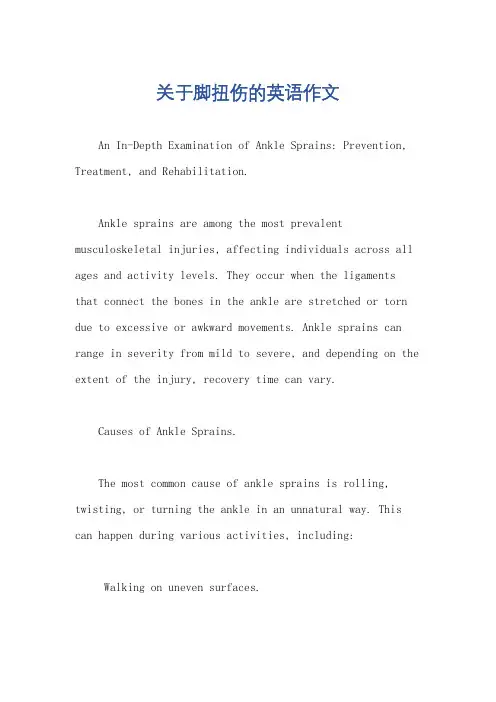
关于脚扭伤的英语作文An In-Depth Examination of Ankle Sprains: Prevention, Treatment, and Rehabilitation.Ankle sprains are among the most prevalent musculoskeletal injuries, affecting individuals across all ages and activity levels. They occur when the ligamentsthat connect the bones in the ankle are stretched or torn due to excessive or awkward movements. Ankle sprains can range in severity from mild to severe, and depending on the extent of the injury, recovery time can vary.Causes of Ankle Sprains.The most common cause of ankle sprains is rolling, twisting, or turning the ankle in an unnatural way. This can happen during various activities, including:Walking on uneven surfaces.Playing sports, especially those involving running and cutting.Falling or tripping.Certain factors can increase the risk of ankle sprains, such as:Weak ankles: Individuals with weak ankles are more likely to experience sprains due to insufficient support and stability.Improper footwear: Wearing shoes that do not provide adequate support or cushioning can increase the risk of ankle sprains.Previous ankle sprains: Individuals who have previously sprained their ankles are more likely to experience another sprain.Symptoms of Ankle Sprains.The severity of ankle sprains depends on the extent of ligament damage. Symptoms may include:Pain: Pain is the most common symptom of an ankle sprain and is usually localized to the area of the injury.Swelling: Swelling around the ankle is a sign of inflammation and may indicate a more severe sprain.Bruising: Bruising can occur as a result of blood vessels being damaged during the sprain.Difficulty walking: Depending on the severity of the sprain, individuals may experience difficulty walking or putting weight on the affected ankle.Instability: Ankle sprains can lead to instability, making it difficult to maintain balance and walk normally.Types of Ankle Sprains.Ankle sprains are classified into three grades based onthe severity of the injury:Grade 1: This is the mildest type of ankle sprain, involving a slight stretching or tearing of the ligaments. Symptoms include mild pain, swelling, and discomfort.Grade 2: Grade 2 ankle sprains involve a partial tearing of the ligaments. Symptoms include moderate pain, significant swelling, and difficulty walking.Grade 3: Grade 3 ankle sprains are the most severe and involve a complete tearing of the ligaments. Symptoms include severe pain, extreme swelling, bruising, and instability.Treatment of Ankle Sprains.The treatment of ankle sprains depends on the severity of the injury. In most cases, the initial treatment involves the RICE protocol:Rest: Avoid putting weight on the injured ankle toallow it to heal.Ice: Apply ice packs to the ankle for 15-20 minutes at a time to reduce pain and swelling.Compression: Use an elastic bandage to wrap the ankle and provide support.Elevation: Keep the injured ankle elevated above the level of the heart to reduce swelling.For more severe ankle sprains, additional treatment may be necessary, such as:Immobilization: A walking boot or crutches may be used to immobilize the ankle and prevent further injury.Physical therapy: Physical therapy can help restore range of motion, strengthen the ankle, and improve balance.Surgery: In rare cases, surgery may be necessary to repair severely torn ligaments.Prevention of Ankle Sprains.Preventing ankle sprains is crucial to maintaining mobility and overall well-being. Here are some preventive measures:Strengthening exercises: Regularly performing ankle strengthening exercises can help improve stability and reduce the risk of sprains.Proper footwear: Wear shoes that provide good support, cushioning, and stability for the activities youparticipate in.Warm-up and stretching: Warming up before exercise and stretching the ankles can help prepare the body for physical activity.Avoid uneven surfaces: Pay attention to the terrain you are walking or running on and avoid uneven surfacesthat may increase the risk of falls or ankle sprains.Rehabilitation after Ankle Sprains.Rehabilitation after an ankle sprain is essential to regain full function and prevent recurrence. Rehabilitation should focus on:Restoring range of motion: Gentle stretching and exercises can help restore the ankle's range of motion.Strengthening the ankle: Progressive strengthening exercises gradually increase the strength of the ankle muscles and ligaments.Improving balance: Balance exercises help improve stability and reduce the risk of future sprains.Proprioception training: This involves exercises that enhance the brain's awareness of the ankle's position and movement.Conclusion.Ankle sprains are common injuries that can range from mild to severe. Understanding the causes, symptoms, and treatment options is crucial for effectively managing and preventing ankle sprains. By following preventive measures and engaging in proper rehabilitation, individuals can minimize the risk of ankle sprains and maintain optimal mobility.。
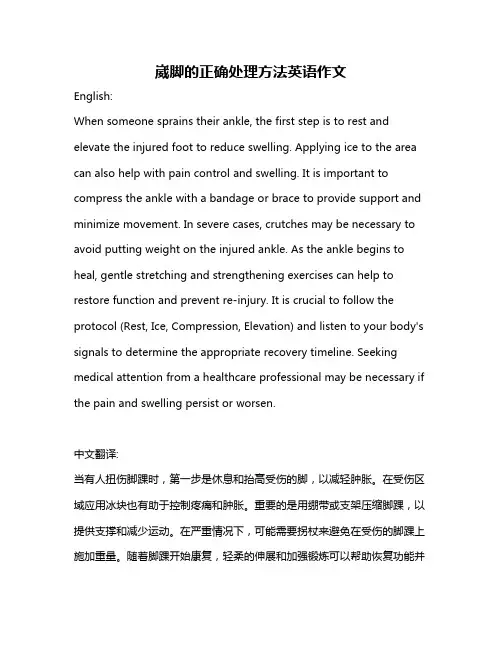
崴脚的正确处理方法英语作文English:When someone sprains their ankle, the first step is to rest and elevate the injured foot to reduce swelling. Applying ice to the area can also help with pain control and swelling. It is important to compress the ankle with a bandage or brace to provide support and minimize movement. In severe cases, crutches may be necessary to avoid putting weight on the injured ankle. As the ankle begins to heal, gentle stretching and strengthening exercises can help to restore function and prevent re-injury. It is crucial to follow the protocol (Rest, Ice, Compression, Elevation) and listen to your body's signals to determine the appropriate recovery timeline. Seeking medical attention from a healthcare professional may be necessary if the pain and swelling persist or worsen.中文翻译:当有人扭伤脚踝时,第一步是休息和抬高受伤的脚,以减轻肿胀。

脚踝扭伤急救英语作文Ankle sprains are a common injury that can occur during physical activities such as running, jumping, and playing sports. They can also happen during everyday activitiessuch as walking on uneven surfaces. A sprained ankle occurs when the ligaments that support the ankle joint are stretched or torn.If you or someone you know experiences an ankle sprain,it is important to know how to provide first aid. Here are the steps to follow:1. Stop the activity and restIf you or someone else has sprained their ankle, thefirst thing to do is to stop the activity that caused the injury and rest. Continuing to put weight on the injured ankle can make the injury worse.2. Ice the ankleIce can help reduce swelling and pain. Apply an ice pack or a bag of frozen vegetables wrapped in a towel to the injured ankle for 20 minutes at a time, several times a day.Do not apply ice directly to the skin, as this can cause frostbite.3. Compress the ankleWrap a compression bandage around the ankle to help reduce swelling. Make sure the bandage is snug but not too tight. If the bandage is too tight, it can cut off circulation and make the injury worse.4. Elevate the ankleElevate the injured ankle above the level of the heartto reduce swelling. Use a pillow or other soft object to prop up the ankle and keep it elevated.5. Take pain relieversOver-the-counter pain relievers such as ibuprofen or acetaminophen can help reduce pain and inflammation. Follow the dosage instructions on the package.6. Seek medical attentionIf the ankle is severely swollen or if you are unable to put weight on it, seek medical attention. A doctor may recommend an X-ray to check for a more serious injury such as a fracture.7. Rest and rehabResting the ankle and avoiding activities that cause pain or discomfort is important for healing. Once the ankle begins to heal, rehabilitation exercises can help restore strength and range of motion.In conclusion, ankle sprains are a common injury that can be treated with first aid. Remember to rest, ice, compress, and elevate the ankle, take pain relievers if needed, and seek medical attention if the injury is severe. With proper care, most ankle sprains will heal within a few weeks.。

脚踝扭伤急救英语作文英文回答:I remember one time when I was playing basketball with my friends, I landed awkwardly after going up for a rebound and ended up twisting my ankle pretty badly. It was a sharp pain that shot up my leg, and I knew I needed to act fast to prevent further injury.The first thing I did was to sit down and elevate my leg to reduce swelling. I also asked one of my friends to bring me some ice to apply to the affected area. Ice can help numb the pain and reduce inflammation, which iscrucial in the initial stages of a sprain.After icing my ankle for about 15-20 minutes, I slowly tried to put weight on it to see if I could bear any pressure. However, the pain was still intense, so I decided to wrap it with a compression bandage to provide some support. This helped stabilize my ankle and prevent it frommoving too much, which could worsen the injury.I also made sure to keep my ankle elevated whenever possible and avoid putting too much weight on it. I used crutches to move around and took it easy for the next few days to allow my ankle to heal properly.It took some time, but with proper rest, ice, compression, and elevation (RICE), my ankle eventually healed and I was back on the basketball court in no time.中文回答:有一次我和朋友们一起打篮球,跳起来抢篮板时着地的时候姿势不对,结果扭伤了脚踝。
英语作文脚受伤了怎么办What to Do When Your Foot Is Injured。
Injuries can happen to anyone at any time, and one of the most common types of injuries is a foot injury. Whether you have sprained your ankle, strained your Achilles tendon, or broken a bone in your foot, it is important to know what to do when your foot is injured. In this article, we will discuss some of the steps you can take to care for your injured foot and promote healing.Step 1: Rest and Elevate Your Foot。
The first thing you should do when you injure your foot is to rest it. Avoid putting weight on the injured foot and try to keep it elevated above your heart as much as possible. This will help to reduce swelling and pain.Step 2: Apply Ice。
Applying ice to your injured foot can also help to reduce swelling and pain. Wrap a bag of ice or a cold packin a towel and apply it to the injured area for 15-20 minutes at a time, several times a day.Step 3: Use Compression。
有人脚踝扭伤了应该如何施救的英语作文When someone twists their ankle, it can be a painful and potentially serious injury. Knowing how to provide immediate care can make a big difference in the person's recovery. Here are some steps to follow when someone twists their ankle:1. Stay calm: If you witness someone twisting their ankle, it's important to stay calm and reassure the person that help is on the way. Panicking will only make the situation worse.2. Rest and elevate: The first thing to do is to help the person sit or lie down and elevate their ankle. This will help reduce swelling and pain.3. Apply ice: Applying ice to the injured area can also help reduce swelling and pain. Make sure to wrap the ice pack in a cloth or towel to prevent skin damage.4. Compression: Wrapping a bandage around the ankle can help stabilize it and reduce swelling. Make sure the bandage is snug but not too tight.5. Keep it elevated: Keep the injured ankle elevated for at least 24 hours after the injury. This will help reduce swelling and promote healing.6. Pain relief: If the person is in pain, you can give them over-the-counter pain medication like ibuprofen or acetaminophen. Make sure to follow the recommended dosage.7. Seek medical attention: If the pain and swelling don't improve after a day or two, or if the person is unable to put weight on their ankle, it's important to seek medical attention. An X-ray may be needed to rule out a more serious injury like a fracture.In conclusion, knowing how to provide immediate care for a twisted ankle can make a big difference in the person's recovery. By following these steps, you can help the injured person feel more comfortable and promote healing. Remember to stay calm, rest and elevate the ankle, apply ice, compress the injury, keep it elevated, provide pain relief, and seek medical attention if necessary.。
扭伤脚踝英语短语Ankle sprain is a common injury that occurs when the ligaments in the ankle are stretched or torn due to sudden and unexpected movement of the joint. This type of injury can happen during physical activity, such as playing sports, or even in everyday activities like walking on uneven ground. Regardless of the cause, an ankle sprain can be a painful and debilitating experience that requires proper treatment and rehabilitation to ensure a full recovery.One of the most common symptoms of an ankle sprain is pain and swelling around the affected area. The severity of the pain can range from mild discomfort to intense, throbbing pain that makes it difficult to bear weight on the injured foot. In addition to pain, the ankle may also appear bruised or discolored, and the individual may experience limited range of motion and difficulty walking.The severity of an ankle sprain is typically classified into three grades based on the extent of the ligament damage. A Grade 1 sprain involves a mild stretch or tear of the ligament, with minimal swelling and instability. A Grade 2 sprain is a more severe injury, with a partialtear of the ligament and moderate swelling and instability. A Grade 3 sprain is the most serious, involving a complete tear of the ligament and significant swelling, instability, and pain.Regardless of the severity of the injury, it is important to seek medical attention as soon as possible. A healthcare professional, such as a doctor or physical therapist, can perform a thorough examination and determine the appropriate course of treatment. In some cases, imaging tests such as X-rays or MRI scans may be ordered to rule out other injuries, such as a fracture or dislocation.The initial treatment for an ankle sprain typically involves the RICE (Rest, Ice, Compression, Elevation) method. This involves resting the injured ankle, applying ice to reduce swelling and pain, using a compression bandage to provide support, and elevating the foot above the level of the heart to help reduce inflammation. Over-the-counter pain medication may also be recommended to manage pain and discomfort.As the injury begins to heal, the focus of treatment shifts to rehabilitation exercises and physical therapy. These exercises are designed to restore range of motion, improve strength and stability, and help the individual regain full function of the injured ankle. Depending on the severity of the sprain, the rehabilitation process may take several weeks or even months to complete.One of the key components of ankle sprain rehabilitation is proprioceptive training, which involves exercises that challenge the body's ability to sense its position and movement in space. This type of training helps to improve balance, coordination, and neuromuscular control, which can help prevent future ankle injuries.In addition to proprioceptive training, other rehabilitation exercises may include:- Range of motion exercises to restore full mobility of the ankle joint - Strengthening exercises to target the muscles and tendons that support the ankle- Balance and stability exercises to improve overall coordination and reduce the risk of re-injury- Gait training to help the individual relearn proper walking and running mechanicsThroughout the rehabilitation process, it is important for the individual to follow the instructions of their healthcare provider and to be patient and consistent with their exercises. Rushing back to physical activity too soon can lead to further injury and delayed healing.Once the individual has regained full range of motion, strength, andstability in the injured ankle, they may be able to gradually return to their normal physical activities. However, it is important to continue to take precautions and to wear appropriate supportive footwear to reduce the risk of re-injury.In addition to the physical aspects of an ankle sprain, the injury can also have psychological and emotional consequences. The pain and limited mobility can be frustrating and disruptive to an individual's daily life and activities. It is important for the individual to seek support from friends, family, and healthcare providers to help manage the emotional and psychological aspects of the injury.In conclusion, an ankle sprain is a common and often painful injury that requires prompt medical attention and a comprehensive rehabilitation plan to ensure a full recovery. By following the RICE method, engaging in targeted rehabilitation exercises, and taking the necessary precautions to prevent re-injury, individuals can successfully overcome an ankle sprain and return to their normal physical activities. With patience, persistence, and the support of healthcare professionals, the road to recovery from an ankle sprain can be a challenging but ultimately rewarding journey.。
Dealing with a Twisted Ankle: A PersonalJourneyIn the blink of an eye, my carefully planned weekend of hiking in the beautiful mountainside turned into a nightmare. All it took was a simple step on an uneven rock, and my foot twisted in an awkward direction, sending a jolt of pain through my entire body. It was clear immediately that I had twisted my ankle, and my hopes of enjoying a peaceful hike were dashed.As I sat there, trying to gather my wits and assess the damage, I realized that the pain was severe, but it wasn't debilitating. I was able to move my foot and ankle in some directions, but certain movements were too painful to attempt. My first instinct was to panic, but I quickly realized that panic would not help me in this situation. I needed to stay calm and assess my options.I knew that the first step was to immobilize the ankle to prevent further injury. I rummaged through my hiking pack and found my emergency supplies, including a roll of gauze and a small first aid kit. I wrapped the gauzetightly around my ankle, doing my best to support it andkeep it from moving. Then, I slowly and carefully began to make my way back to the trailhead, hoping that I wouldn't encounter any more obstacles.The hike back was agonizingly slow. Every step sent a sharp pain through my ankle, and I had to stop frequentlyto rest. But I knew that if I didn't keep moving, the situation could potentially worsen. So, I pressed on, one painful step after another.Finally, after what seemed like an eternity, I made it back to the trailhead. My ankle was throbbing by this point, and I knew that I needed to seek medical attention. Fortunately, there was a small clinic nearby, and I wasable to hobble my way there with the help of a passerby.The doctor examined my ankle and confirmed that I had twisted it badly. He advised me to rest it for a few days and avoid putting any weight on it. He also prescribed some pain medication and gave me a brace to support my ankle.The next few days were a blur of pain and boredom. Iwas forced to stay off my feet, which was a difficult task for someone who is normally always on the go. But I knewthat it was necessary for my ankle to heal properly. So, I did my best to rest and follow the doctor's advice.In hindsight, I realize that I was lucky. My twisted ankle was painful, but it wasn't a serious injury that required surgery or months of recovery. I was able to heal relatively quickly, and within a few weeks, I was back onmy feet and able to resume my normal activities.This experience taught me a valuable lesson about the importance of being prepared for the unexpected. It also taught me the value of staying calm and composed in timesof crisis. Most importantly, it taught me to appreciate the simple joy of being able to walk pain-free and to cherish the ability to explore the outdoors and enjoy nature's beauty.**扭伤脚的应对之道:一次个人经历**眨眼之间,我原本精心计划的周末山间徒步旅行就变成了噩梦。
体育课脚扭伤了进行急救的英语作文英文回答:First Aid for a Sprained Ankle.RICE Method:R Rest: Avoid walking or putting weight on the injured ankle. Use crutches or a wheelchair if necessary.I Ice: Apply an ice pack to the injured area for 15-20 minutes at a time, several times a day.C Compression: Wrap the injured ankle with an elastic bandage to provide support and reduce swelling.E Elevation: Keep the injured ankle elevated above the level of your heart to reduce swelling.Additional First Aid Measures:Immobilize the ankle: Use a splint or brace to keepthe ankle in place and prevent further injury.Take over-the-counter pain medication: Such as ibuprofen or acetaminophen, to reduce pain and inflammation.Get medical attention: If the pain is severe, you cannot walk on the ankle, or swelling and bruising worsen, seek medical attention immediately.Rehabilitation for a Sprained Ankle:After the initial injury has been treated, it is important to follow a rehabilitation program to strengthen the ankle and restore full range of motion. This may include:Stretching: Gently stretch the ankle muscles toimprove flexibility.Strengthening exercises: Perform exercises such ascalf raises, ankle circles, and balancing exercises to strengthen the muscles around the ankle.Progressive walking and running: Gradually increase the amount of time spent walking and running on the injured ankle.Proprioception exercises: Exercises that challenge your balance and coordination to improve stability in the ankle.Prevention of Ankle Sprains:Wear supportive footwear: Wear shoes that provide arch support and stability for your ankles.Warm up before exercise: Stretching and warming up the ankle muscles before exercising can help prevent sprains.Strengthen ankle muscles: Regularly perform ankle strengthening exercises to improve stability and prevent injuries.Watch your footing: Pay attention to uneven surfaces or obstacles that could cause you to twist or roll your ankle.中文回答:脚踝扭伤急救。
Dealing with a Twisted Ankle: A PersonalExperienceOne sunny afternoon, I found myself on the sidewalk, clutching my ankle in pain. It had happened so suddenly - one step, and then a sharp twist, followed by a jolt of pain that nearly brought me to my knees. It was obvious; I had twisted my ankle.The first moments were a blur of panic and confusion. I looked down at my foot, trying to assess the damage. It was swollen and painful, but there was no obvious deformity. I knew I needed to stay calm and assess the situation. I took a few deep breaths and began to limp slowly towards the nearest bench.Sitting down, I took out my phone and googled "what to do when you twist your ankle." The internet was a wealth of information, and I quickly learned that the initial steps were crucial. I elevated my foot, applied some light pressure to the area, and began to ice it. The pain wasstill there, but the swelling began to subside.Over the next few days, I followed the advice I had found online. I rested, iced, compressed, and elevated my ankle whenever possible. I also visited a doctor to ruleout any serious damage. Fortunately, the x-rays showed no fractures, and I was told to continue with my home care.The recovery process was slow but steady. I gradually began to put more weight on my foot, and the pain began to ease. I was careful not to rush the process, knowing that a premature return to activity could worsen the injury.In hindsight, I am grateful for the experience. It taught me the importance of being prepared and taking careof myself when faced with an injury. It also taught me the value of listening to my body and respecting its limits.扭伤脚踝的个人经历一个阳光明媚的下午,我发现自己站在人行道上,紧紧地抓住脚踝,疼痛难忍。